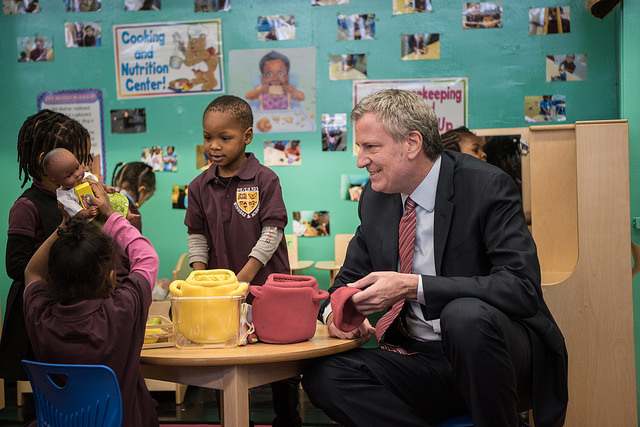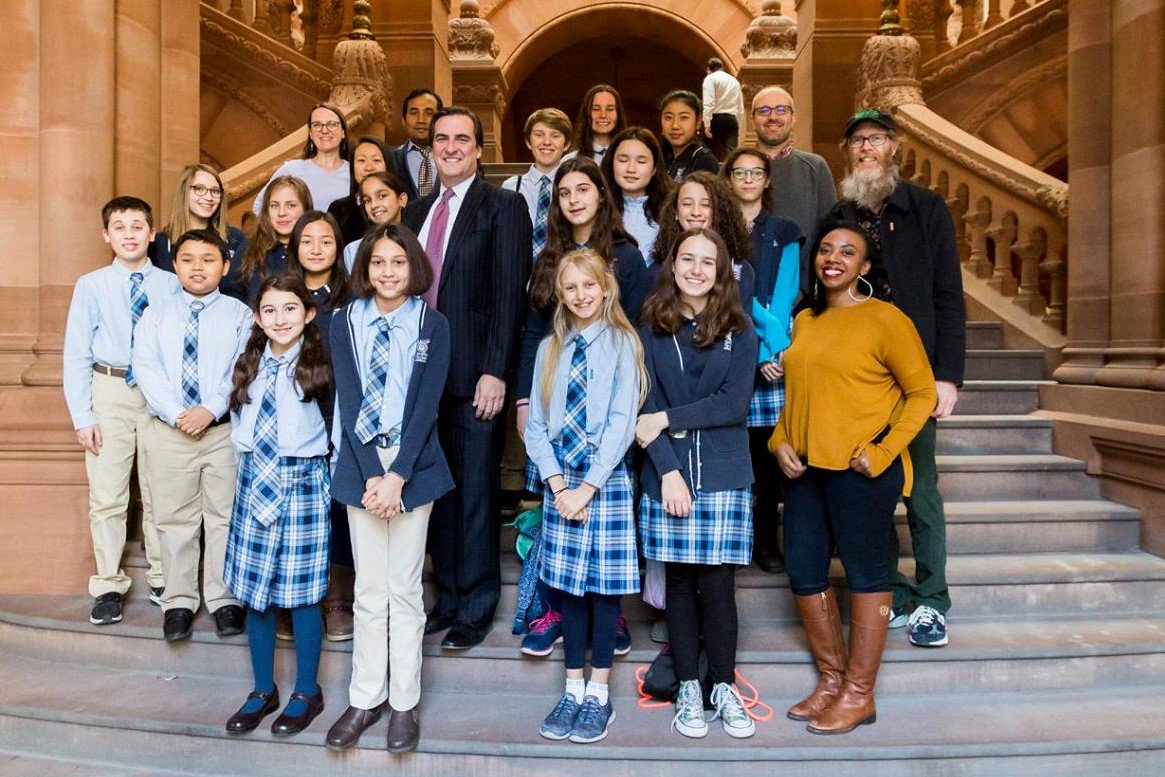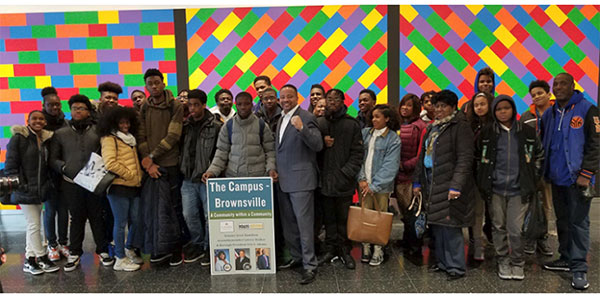The Failure of 'Renewal Schools'

Mayor de Blasio on a school visit (photo: Michael Appleton/Mayor's Office)
My daughter is a third-grader in one of Mayor de Blasio’s so-called Renewal Schools in Harlem. When I first heard about the program, I was hopeful: P.S. 149 needed attention and change to become the kind of school I wanted for my daughter. But, as a parent, I have not seen much renewal.
Since the program started, enrollment at P.S. 149 has dropped 25 percent. For the kids who have stayed, scores haven’t improved much – students passing the English Language Arts exam has gone from 5 percent in 2014 to 13 percent in 2017. The math pass rate has dropped from 8 percent to 5 percent over the same time. So despite all the resources the Department of Education claims to have pumped into our school, fewer students are doing math at grade level.
When Mayor de Blasio announced his Renewal Schools program, he promised that his “bold new plan” would be the key to turning around chronically-struggling public schools like my daughter’s. Four years and $600 million later, there is little to show for it. None of the schools have come close to any sort of “renewal” and the mayor has been forced to close nine of them and merge others. Just a handful of the original 94 Renewal Schools have seen real improvement.
For me, this broken promise means a lot more than just numbers on a state test. My daughter is struggling in reading and math, and nothing the mayor has done these past few years has helped her school improve.
When I realized my daughter needed extra help, I reached out to the school’s parent coordinator – I’m not about to give up on my child. The coordinator promised to look for outside resources that might offer her the support she needs. I appreciate the effort, but why do we need outside resources when our school is supposed to be part of the mayor’s major project? If his program were of high quality, my daughter’s school would be able to provide a good education for kids inside the classroom, and parents like me wouldn’t be scrambling.
I am so discouraged with the state of the district schools in my neighborhood. The system is failing communities like mine all over the city – the same communities that elected this mayor. At the end of the day, it’s becoming clear that we can’t depend on Mayor de Blasio to improve struggling schools for children of color.
That’s why I’m trying to get my daughter a spot in a charter school, where kids like her have a shot to catch up. It’s really her only hope.
The problem is that there aren’t enough spaces at charter schools. I guess the mayor knows that if parents like me had a choice, we’d leave, just like a quarter of our school already has.
The mayor shouldn’t be the only one with a say here. The New York City Council will be holding a hearing on Tuesday, Feb. 27 – and I hope Council members get to the bottom of this failed experiment. Our Council members live in our neighborhoods and they see what’s happening in our schools. They need to step up because our communities can’t wait another four years for Mayor de Blasio to figure things out.
As I keep fighting for my daughter, my son is getting ready for kindergarten. I am trying to do everything I can to make sure he’s on a better path. Knowing what I know now, I am fighting like hell to get him into a charter school right from the start. As a single mom, juggling two different schools will be hard, but I would do anything to get my kids a better education.
If Mayor de Blasio was really focused on turning around struggling schools, me and my kids wouldn’t be in the situation we’re in now. The mayor’s “bold new plan” is nothing more than another broken promise.
***
Aradany Vargas is a public school parent at P.S. 149 Sojourner Truth.
***
Have an op-ed idea or submission for Gotham Gazette? Email This email address is being protected from spambots. You need JavaScript enabled to view it.
Let’s Lead the Way on Gun Background Checks in New York

Senator Gianaris, the author, with young people (photo via @SenGianaris)
72 hours.
That is how long one needs to wait for a background check before buying a high-capacity gun capable of mass slaughter. Three days is all it took for Dylann Roof to purchase his .45 caliber Glock and kill nine people who sat praying in Emanuel AME Zion Church in Charleston, South Carolina. Roof bought his gun without completing a background check because current law authorizes a gun purchase after three days, regardless of whether or not a background check has been completed. Roof, with his prior convictions, would have failed a background check and should not have been able to acquire his firearm. The victims should still be with their families today.
Right here in New York, Jiverly Wong purchased a handgun in Binghamton in 2009 after three days, even though a background check – which may have prevented the purchase due to a history of mental health issues – was not completed. Just a month later, he walked into a naturalization class at a local community center and killed 13 people.
As the nation reels from another horrifying tragedy, this time in Parkland, Florida, thoughts and prayers are insufficient to stop future calamities. The time for action is at hand. Grieving teenagers mourning their classmates should not shoulder the burden of a nation; state and federal leaders must do something to prevent even more parents from burying their children.
In 2016, the federal government authorized more than 300,000 prospective gun purchases before background checks were completed. This means thousands of weapons in the hands of potentially dangerous people – those with criminal histories and mental illnesses, as well as domestic abusers.
In New York State, we can lead the way on avoiding these preventable tragedies: I introduced the Effective Background Check Act, legislation lengthening the waiting period for a background check from the current three days to a full 10, giving more time for checks to be completed and keeping weapons out of the hands of potential killers.
This effort is even more important now as the Trump administration seeks to reduce funding for the National Instant Criminal Background Check System (NICS), which would further slow the ability of the FBI to perform timely background checks. As Parkland parents buy caskets for their children instead of graduation gowns, Donald Trump needs to recognize this is the worst possible time to abdicate his responsibilities.
Leaders on all sides of the aisle must rally around the crisis our nation is facing: too many people are dying of preventable gun deaths. On average, 96 people die each day from guns. Because of background checks, we have stopped more than 3 million gun sales to prohibited people, saving countless lives. With a longer waiting period, we could save even more.
Could a few days’ time have made a difference in these tragedies? Could one of those more than 300,000 gun purchases in 2016 be the next mass shooting? Could one of those be the perpetrator of domestic violence against his or her partner or child? Are those extra hours worth saving the lives of innocent men, women, and children who may be gunned down in movie theaters, on street corners, or in their schools?
240 hours. That is how long a gun purchaser would need to wait to complete a background check if New York enacts my Effective Background Check Act. For all those whose lives were cut short by years, we owe them this extra time.
***
Michael Gianaris is a state senator representing the 12th Senate District, in Queens. On Twitter @SenGianaris.
***
Have an op-ed idea or submission for Gotham Gazette? Email This email address is being protected from spambots. You need JavaScript enabled to view it.
Teaching Black History in Our Schools

Senator Jesse Hamilton, the author (middle)
Last summer, I hosted a hackathon for middle school students at Medgar Evers College. Picture 40 enthusiastic young people ready to learn about coding, computer science, and technology, along with CodeEd educators and the welcoming college staff.
In an effort to be as educational as possible, I like to do a little history quiz when we host young people. My quiz features questions like, “Who was the first African-American woman elected to Congress?” That day, I asked, “Who was Medgar Evers?” Silence. The question stumped nearly all the students.
Only one student could venture a reply on his Civil Rights Movement leadership. That lone reply is part of the reason I am advancing legislation to make black history instruction in our K-12 schools mandatory.
The Southern Poverty Law Center recently published a troubling report on schools teaching the history of slavery, “Teaching Hard History.” Among the most alarming findings, SPLC reports that two-thirds of high school seniors did not know it took a constitutional amendment to end slavery; 58 percent of teachers found their textbooks inadequate in teaching about slavery; the average textbook scored only 46 percent in SPLC’s assessment of what should be included in the study of American slavery; 40 percent of teachers believed their state offers insufficient support for teaching about slavery.
The SPLC’s analysis provides important data supporting the need to make black history instruction mandatory, mirroring my experience with the hackathon students and elsewhere.
Recent news reports underscore the necessity of this legislation. In one Bronx school, I.S. 224, the principal reportedly instructed an English teacher not to teach about the Harlem Renaissance. In another school, administrators refused to allow a student named Malcolm Xavier Combs to put “Malcolm X” on his senior sweater. In another instance, in Park Slope, the PTA included images of performers in blackface on advertisements for a 1920s themed fundraiser. Passing this law would send a clearly needed message of inclusion to all New Yorkers.
Black history’s importance extends far beyond a single month. From the abolitionists like Sojourner Truth, who broke barriers in advocacy and helped end slavery, to the Harlem Renaissance, home to literary and artistic dynamism we benefit from even today, to the pioneering achievements of Shirley Chisholm, who paved a path for future public servants of color, men and women alike, black history serves as part of our national heritage.
Our young people should engage with black history in thoughtful, age-appropriate ways, throughout their time as students. Black history provides a panoply of avenues across subject areas for K-12 students to explore, intersecting with social studies, English language arts, performing and visual arts, and more. I have every confidence that the Board of Regents and educators across various disciplines can successfully weave the richness of black history and New York’s unique place in black history into school curricula.
A crossroads for the world, New York’s Black History intersects with experiences of the Afro-Caribbean community, the Afro-Latino community, and the entire African diaspora. Under the provisions of my black history in schools proposal, the Board of Regents would be responsible for determining how Black History is best incorporated into students’ studies.
Sociologists point to the black experience being underrepresented overall in media, missing stories altogether, exaggeration of negative portrayals, and providing positive portrayals within only a narrow scope. These broader facts have consequences for young peoples’ development, self-esteem, expectations, and what figures are even available as role models. Requiring black history in schools is not a silver bullet, but it marks an important further development in chipping away at stultifying boundaries to opportunities.
I invite the public to join in support of an holistic effort to think about black history and participate in embracing a curriculum recognizing New York’s unique place in black history. New York is blessed with a rich variety of institutions that can contribute to making this inclusive move a success, the Weeksville Heritage Center in Brooklyn, the Schomburg Center for Research in Black Culture in Harlem, and all our museums, libraries, and numerous institutions of higher education can make valuable contributions to this effort.
This broader integration of black history into our schools is as important to our future as the coding and computer science those middle school students learned at Medgar Evers College. Such a curriculum leaves the boundaries of the schoolhouse and will help bolster New York students’ college- and career-readiness, engaging them, sharpening their skills, and preparing them for the diverse and dynamic communities they will lead their lives in.
***
Jesse Hamilton is a state senator representing Brooklyn’s 20th district. On Twitter @SenatorHamilton.
***
Have an op-ed idea or submission for Gotham Gazette? Email This email address is being protected from spambots. You need JavaScript enabled to view it.




